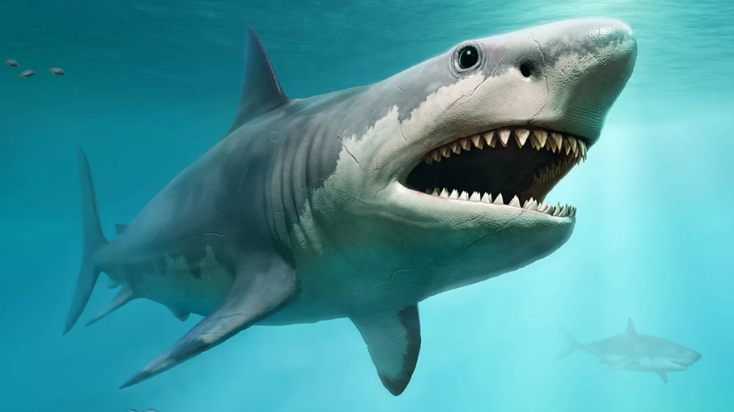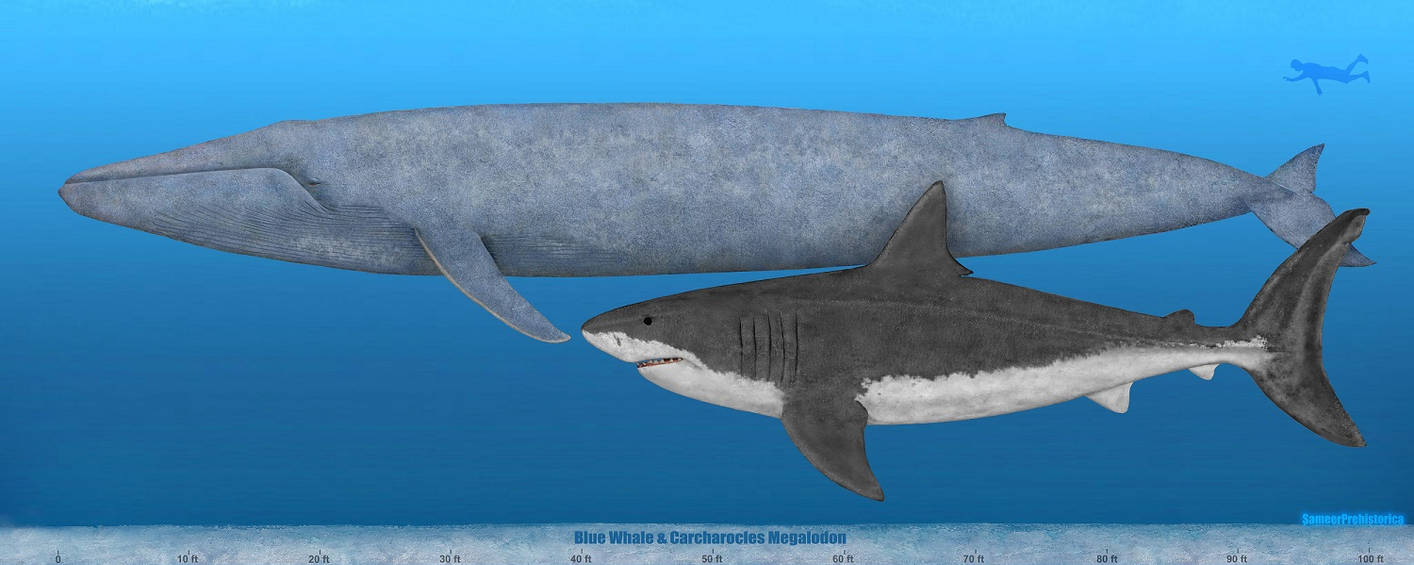Megalodon vs. Blue Whale: An Epic Battle of Prehistoric Giants
The oceans have been home to some of the most magnificent and massive creatures in Earth's history. Among them, the Megalodon and the Blue Whale stand out as two colossal creatures that have captured our imagination. In this article, we delve into the hypothetical showdown between the Megalodon and the Blue Whale, exploring their characteristics, habitats, and what might happen if these prehistoric giants were to cross paths.

Megalodon
1. The Megalodon:
Ancient Apex Predator The Megalodon, an extinct species of shark, once ruled the oceans as a fearsome apex predator:
1.1. Gigantic Dimensions: Megalodons could reach lengths of up to 60 feet or more, making them one of the largest predators to have ever existed.
1.2. Formidable Teeth: Their massive serrated teeth, some exceeding 7 inches in length, were perfectly designed for hunting and tearing through prey.
1.3. Prey and Hunting: Megalodons predominantly fed on large marine mammals like whales, seals, and other marine creatures, using their powerful jaws and teeth to incapacitate their prey.
2. The Blue Whale:
Earth's Largest Creature The Blue Whale holds the title of being the largest animal to ever exist on Earth:
2.1. Unmatched Size: Blue Whales can grow to lengths of over 100 feet and weigh as much as 200 tons, with a heart that can be the size of a small car.
2.2. Herbivorous Diet: Blue Whales are filter feeders, consuming massive quantities of krill and small marine organisms by using their baleen plates to filter food from the water.
2.3. Gentle Giants: Despite their immense size, Blue Whales are known for their gentle nature and slow movements.
3. Hypothetical Battle:
Megalodon vs. Blue Whale While the Megalodon and Blue Whale existed in different time periods, imagining a confrontation between these giants is intriguing:
3.1. Hunting Tactics: In a hypothetical encounter, the Megalodon's predatory instincts might drive it to target a Blue Whale, sensing its enormous size as an opportunity for a substantial meal.
3.2. Size Advantage: The Blue Whale's colossal dimensions could potentially act as a defense mechanism, making it challenging for the Megalodon to approach and deliver a lethal bite.
3.3. Evading and Escaping: Blue Whales are known for their ability to dive to great depths and use their tail flukes to create powerful waves, potentially enabling them to escape a Megalodon's pursuit.
4. Habitat and Environmental Factors:
Considering the habitats and environments of these creatures adds complexity to their hypothetical interaction:
4.1. Oceanic Territories: Both the Megalodon and Blue Whale inhabited the open oceans, traversing vast distances in search of food and suitable habitats.
4.2. Ocean Dynamics: The dynamic nature of ocean currents and depths would influence how these creatures encounter each other and engage in any hypothetical interaction.
5. The Role of Extinction:
While the Megalodon went extinct around 2.6 million years ago, Blue Whales continue to thrive:
5.1. Megalodon Extinction: Environmental changes and shifts in prey availability are believed to have contributed to the extinction of Megalodons.
5.2. Blue Whale Resilience: Blue Whales' adaptability and wide distribution have enabled them to survive through different geological eras.
6. The Reality of Coexistence:
In reality, these two giants never crossed paths due to the vast time gap between their existence:
6.1. Geological Time Scale: Megalodons existed during the Cenozoic Era, while Blue Whales are a relatively recent species, making any encounter purely speculative.
6.2. Human Impact: Human activities, such as whaling and habitat degradation, have significantly impacted the populations of Blue Whales in recent times.

Megalodon vs blue whale
The hypothetical clash between the Megalodon and the Blue Whale presents a captivating scenario that taps into our fascination with these colossal creatures. While their sheer size and power are awe-inspiring, the reality of their separate timelines and habitats makes such an encounter an imaginative exercise rather than a historical event. The Megalodon and Blue Whale, as representatives of ancient and contemporary oceanic life, remind us of the incredible diversity and wonder that the world's oceans have to offer.